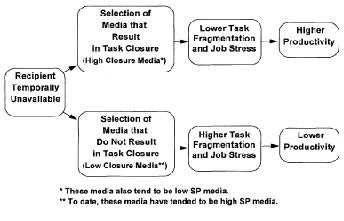Task closure theory

Task closure theory
Acronym
N/A
Alternate name(s)
N/A
Main dependent construct(s)/factor(s)
Productivity, Task fragmentation, Job stress, Task closure (mediating variable), Media selection (mediating variable)
Main independent construct(s)/factor(s)
Social presence, Recipient availability
Concise description of theory
This theory posits that recipient availability and the perceived social presence (SP) of the medium are key indicators in the choice of a communication medium in addition to task and media characteristics. The theory proposes that these characteristics are important in choosing communications media because humans feel the need to bring closure to a communications sequence and will highly motivated to choose the media that will allow them to feel that they have done this. Additionally, selecting media that leads to task closure will lead to lower levels of task fragmentation and job stress. This, in turn, will lead to higher productivity levels.
For example, when using a telephone as the medium, the task has been brought to closure when the sender delivers his or her message to either the receiver, or the receiver’s voice mail. When using e-mail, the sender has brought closure to the task when he or she presses the “send” button. Note that this theory bases its choices on the ability to bring closure and the social presence, not richness of the media. So unlike Media Richness Theory, face-to-face media is on the low end of the spectrum of choices because it depends on the recipient being available to bring closure to the communication. Another noteworthy item is that much of the research literature using this theory uses task closure and media selection not as variables that mediate the levels of job stress and task fragmentation, but as dependent variables.
Diagram/schematic of theory
Originating author(s)
Detmar Straub and Elena Karahanna
Seminal articles
Straub, Detmar, and Karahanna, Elena (1998). "Knowledge Worker Communications and Recipient Availability: Toward a Task Closure Explanation of Media Choice," Organization Science, Vol. 9, No. 2, pp. 1047-7039.
Originating area
Information Systems
Level of analysis
Individual
IS articles that use the theory
Brown, Susan A., Alan R. Dennis, and Viswanath Venkatesh. "Predicting collaboration technology use: Integrating technology adoption and collaboration research." Journal of Management Information Systems 27.2 (2010): 9-54.
Karahanna, E., Moez, L (2000). "E-Mail and V-Mail Usage: Generalizing Across Technologies", Journal of Organizational Computing and Electronic Commerce, Vol. 10 Issue 1, pp.49-66.
Massey, Anne P., and Mitzi M. Montoya-Weiss. "Unraveling the temporal fabric of knowledge conversion: A model of media selection and use." MIS Quarterly (2006): 99-114.
Maznevski, Martha L. and Chudoba, Katherine M (2000). “Bridging Space Over Time: Global Virtual Team Dynamics and Effectiveness”, Organization Science, Vol. 11, No. 5, pp. 1047-7039.
Miranda, Shaila M.; Saunders, Carol S (2003). “The Social Construction of Meaning: An Alternative Perspective on Information Sharing”, Information Systems Research, Vol. 14 Issue 1, p87.
Robertson, M., Sørensen, C., Swan, J (2001). “Survival of the Leanest: intensive knowledge work and groupware adaptation”, Information Technology and People, Vol. 14 No. 4, pp.334-352.
Te’eni, Dov (2001). “Review: A Cognitive-affective Model of Organizational Communication for Designing IT,” MIS Quarterly, Vol. 25 No. 2, 251-312.
Watson-Manheim, Mary Beth, and France Bélanger. "Communication media repertoires: Dealing with the multiplicity of media choices." MIS Quarterly (2007): 267-293.
Links from this theory to other theories
External links
http://scholar.google.com/scholar?q=task+closure+theory&hl=en&lr=, Google Scholar Link
Original Contributor(s)
James Parrish
Please feel free to make modifications to this site. In order to do so, you must register.
Return to Theories Used in IS Research
